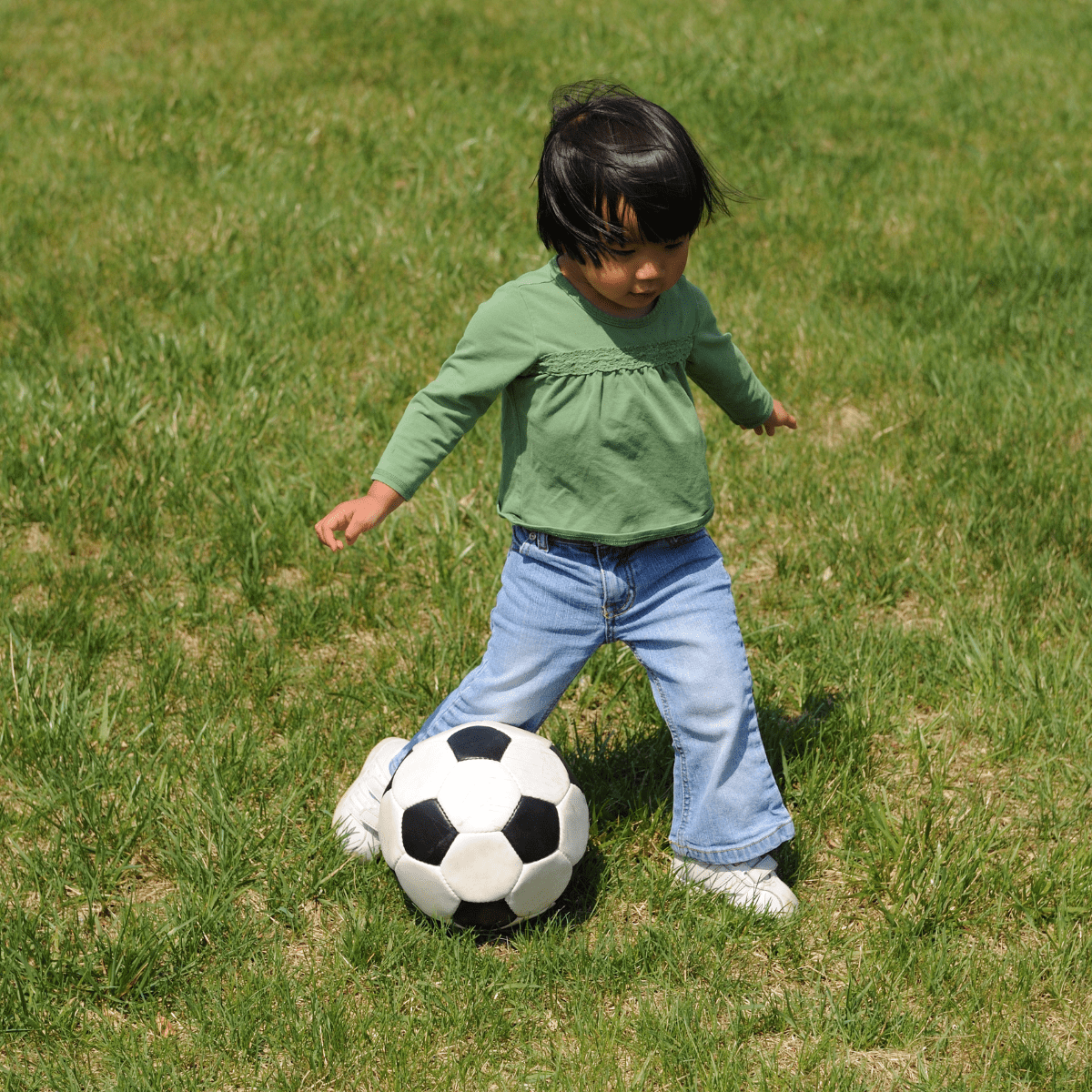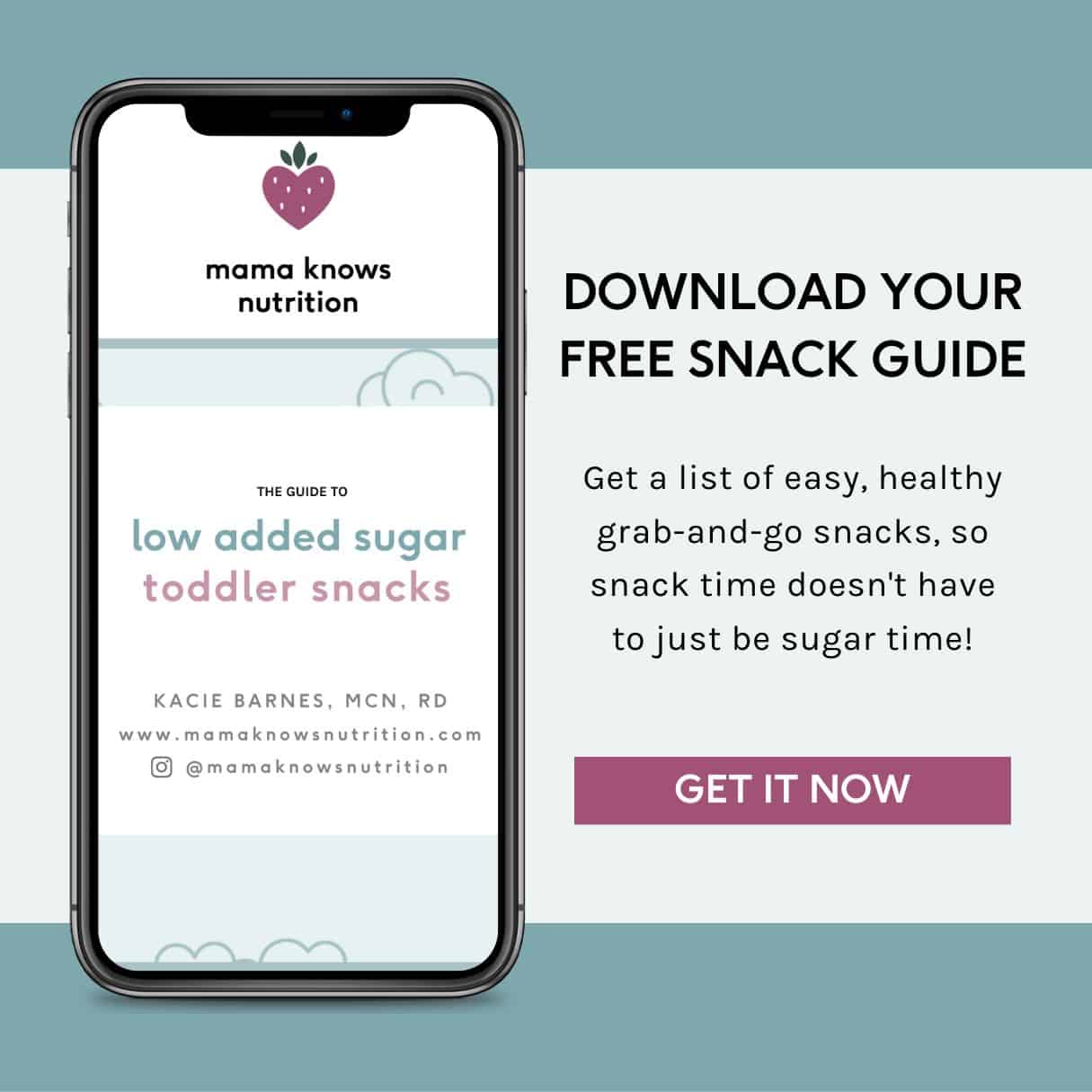Healthy High-Calorie Snacks for School
Mar 01, 2023, Updated Jun 07, 2025
This post contains affiliate links. Please see our disclosure policy.
updated September 2024
When I say packed school snacks, what do you think of? Granola bars? Fruit snacks? Maybe Goldfish?
These snacks are super common in lunch rooms and on playgrounds. And for good reason! Kids love them, they’re easy, and nutritionally speaking, they’re NOT bad to serve. (Don’t let the food “experts” on Instagram with no schooling tell you otherwise!)
But if you’re worried your child isn’t getting enough calories throughout the day, or if your child’s pediatrician wants them to gain weight, carb-forward snacks like these aren’t my first picks. Without much fat or protein, they’re just not going to be that filling or sustaining. And they can be on the low end in calories, too.
This is a follow-up to my blog post on healthy, high-calorie foods for toddlers! It will give you tons of balanced, high-calorie snacks for kids so you can keep your little one fuller for longer, and get as many nutrients per bite into them as possible while they’re out of the house.
Prefer to listen? Check out Episode #33 of the Mama Knows Nutrition Podcast on Healthy, High-Calorie Foods for Kids.

Table of Contents
- Reasons Kids Might Need High-Calorie Snacks for School
- #1 They Need To Gain Weight
- #2 They Lost Their Appetite After Sickness
- #3 They Have A Short Attention Span At Meals
- #4 They’re Active or Recently Changed Their Activity Level
- #5 They Don’t Have Enough Time To Eat
- High-Calorie Foods & Why Some Are Better Than Others
- How To Add Calories To Your Child’s Diet With High-Fat Foods
- High-Calorie Snacks For School
- Packaged High-Calorie Snacks for School
- High-Calorie Snacks for School (keep cool with an ice pack)
- School Packing Favorites
- High-Calorie Meals For School
- High-Calorie Breakfast Ideas & Swaps
- High-Calorie Lunch Ideas & Swaps
- High-Calorie Dinner Ideas & Swaps
- Need Them To Eat More? Keep The Fat High & The Pressure Low
- Free: Healthy Packaged Snacks for Kids
Reasons Kids Might Need High-Calorie Snacks for School
There are lots of reasons why and instances where children might need a higher-calorie snack option.
#1 They Need To Gain Weight
When I say “they need to gain weight,” I mean per their pediatrician’s advice! Not based on their size or a family member’s unsolicited opinions. (Thanks but no thanks, Aunt Karen!) There isn’t just one “normal” body size or “healthy” weight for kids. In fact, the range for what’s considered normal is really wide. Try not to compare your child’s weight to an average, especially a visual one, because there really isn’t an average.
There’s a misconception that the goal is for every child to be at the 50th percentile when, in reality, the goal is for them to stay on their growth trajectory. We all have different heights and weights naturally, so it wouldn’t make sense for everyone to sit right in the middle at the 50th percentile. (What would they even be in the middle of?!)
Kids really can be healthy at any size as long as they’re growing along THEIR growth curve instead of dropping down (or jumping up) too many percentiles. Whether it’s the 5th percentile or the 95th, you want them to be around the same percentile they’ve always been at. If they are, you can feel confident that they’re on track for what THEIR body needs.
All of this said, if you’re concerned about your child’s growth and development, prioritize talking to your pediatrician about it. If your child is falling off their growth curve, their doctor may suggest increasing the calories in their meals and snacks.
And sometimes there are exceptions where a drop in their weight percentile isn’t concerning! It depends on what’s going on specifically with your child. So again, checking in with the pediatrician is a good first step so they can investigate, and hopefully ease your worries.
#2 They Lost Their Appetite After Sickness

Sickness is the worst. Staying home from school, canceling work or meetings, seeing your babe miserable…it affects everything! And their appetite is no exception.
Sickness often zaps young childrens’ appetites in the short term. If they have a 24-hour bug, that’s no big deal. A day of less food won’t hurt them. But when the sickness (and their decreased appetite) lasts longer than that, it can be worrisome! Especially if you worry about them getting enough calories on a good day. Or, if you have a picky eater who’s favorite foods are low-calorie things like fruit.
In practice, I frequently see kids who lose some weight after back-to-back illnesses, often during the winter time when germs are at a high.
#3 They Have A Short Attention Span At Meals
Lots of kids have short attention spans for meals even when they’re seated at the kitchen table at home with relatively few distractions—let alone at school where there are fun things pulling their attention, like friends to see and games to play afterward. Or, where there are not-so-fun things pulling their attention, like intimidation, nerves, or social situations that make kids less comfortable. (Being little is so hard!)
No matter the reason, sometimes it’s just tough for younger kids to sit at the table for more than a few minutes. It’s normal and totally expected! But if it results in them undereating, you may want to offer more high-calorie foods. So that every bite they do take has as much nutrition and as many calories in it as possible!
#4 They’re Active or Recently Changed Their Activity Level

If your child has a high activity level in general or recently increased their activity level by starting a new after-school sport or activity, they’ll be expending a lot of energy! So, they’ll need to replace a lot of energy, too. Higher-calorie foods can make that easier.
#5 They Don’t Have Enough Time To Eat
Childhood is a busy time! A lot of kids’ days are FULL to the brim with busy mornings, full days of school, and after-school activities. Then it’s a bath and straight to bed (we wish!). Busy schedules like these are so fun for lots of kids so it’s not a bad thing, it just means they’re likely to be eating snacks on the go, or you’ll be trying to get a few bites in them on the way out the door in the morning. Having some high-calorie tricks up your sleeve can help ensure that even the busiest kids get the calories they need. One of my favorite on-the-go choices are the KendaKids Vita-Boost Shakes. They’re made with European Whole Milk sourced from grass-fed cows on family-owned farms and contain no added sugar!
High-Calorie Foods & Why Some Are Better Than Others
First of all, high-calorie does not equal unhealthy. LOTS of high-calorie foods are perfectly healthy. It’s just that nutritionally speaking, some calorie-dense foods are better than other foods for weight gain.
One example of this is fat. Fat has more calories per gram than protein or carbs, so if you’re looking for foods that have a better bang for your buck calorie-wise (and you expect your kid to only have a few bites) then something high in fat is the way to go! On that note, high fat doesn’t equal unhealthy, either, as long as you choose the right kinds. There are tons of healthy fats that are super nutritious and great for kids. And these fats aren’t just “not bad” for kids—they’re great! In fact, adding nutritious, high-fat foods to your child’s diet is the best way to increase their calories at meal and snack times.
Should You Just Let Them Eat Ice Cream & Cookies?
I mean, they’re higher in calories, right?

While there is nothing inherently wrong with ice cream, cookies, and other higher-calorie treats, increasing your child’s day-to-day calorie intake with these foods as a mainstay wouldn’t be my first approach. Prioritizing more nutrient-dense foods and higher-calorie foods MOST of the time is will help them get the most calories AND the most nutrition as possible, per bite.
But serving foods like cookies and ice cream sometimes is also not something I’d be worried about! If your child seriously won’t eat anything other than cookies, go ahead and serve them. There are days when you’ve just gotta get something into them! Also, these foods can be a fun way to add in extra calories. Like when you go out for milkshakes or ice cream!

How To Add Calories To Your Child’s Diet With High-Fat Foods
Don’t Stress Over Quantity
When you serve foods high in fat, you don’t need to stress about the quantity. Because fat has more calories per gram than carbs and protein do, more calorie-dense foods tend to make kids feel satisfied faster. (Think of how you might be able to eat a whole bowl of salad or popcorn, but just a scoop or two of ice cream!)
Add, Don’t Replace
Don’t REPLACE anything they’re already eating with fat, just add it. And where there are already fats in their diet, increase the quantity.
Save Milk for Meal & Snack Times
Offer milk at meals and snacks instead of in-between, so they’re actually hungry when it’s time to eat.
High-Calorie Snacks For School
I know everyone’s school is different in what you’re allowed to bring and whether or not they can bring something that needs to stay cool, so I’ll give you some ideas for all scenarios.
Note- this post contains affiliate links. As an Amazon associate, I earn from qualifying purchases at no extra cost to you.
Packaged High-Calorie Snacks for School

- Trail mix of any kind (best for ages 4+)
- Clif Nut Butter Bars (this is our favorite flavor)
- Larabars (favorite!)
- Emmy’s Organics Coconut Cookies
- Nature Valley Biscuits (peanut butter or almond butter)
- KIND Breakfast Bars
- Heavenly Hunks Oatmeal Dark Chocolate
- Granola (their favorite kind packed up to eat dry)
- Snack Size Perfect Bar
- KendaKids Vita-Boost Shakes
High-Calorie Snacks for School (keep cool with an ice pack)
These are nut-free, too!
- Coconut yogurt (like cocojune)
- Peeled hard-boiled eggs
- English muffin or mini bagel with cream cheese, butter, or granola butter
- Cheese and crackers
- Sargento Balanced Breaks (some varieties do contain nuts)
- Guacamole and rolled tortilla chips snack pack
- Hummus and pretzel snack pack
School Packing Favorites

Lunch boxes
- Bentgo Bento Style Lunch Box
- LunchBots Stainless Steel Lunch Container
- Simple Modern Insulated Lunch Bag
- PackIt Freezable Lunch Box Cooler
- Wildkin Kids Insulated Lunch Bag
Snack and hot food containers
- Bumkins Reusable Snack Bags
- Silicone baking cups (great for separating foods in a lunch box!)
- LunchBots Snack and Side Containers
- Zojirushi Thermos (I tested several popular thermoses and this was the winner on keeping food hot until lunchtime!)
- Thermos Funtainer (a great budget option!)
Ice pack
Water bottles
High-Calorie Meals For School
I’m going to share high calorie meal ideas below, but you can also totally take snack inspiration from them. Granola, full-fat yogurt, other full-fat dairy products like cheese, and guacamole with carrots or even tortilla chips are perfect snacks for home or school. Take what you need and feel free to adapt them to your family and your littles!
High-Calorie Breakfast Ideas & Swaps
#1 Swap cereal for granola. Granola usually has much more fat and calories than cereal, and the serving size is smaller so it’s more calorie dense.
#2 Swap low-fat and skim milk for whole milk. Whole milk has more fat and more calories overall.
#3 Serve full-fat yogurt (or coconut yogurt) instead of low-fat yogurt.
#4 Add 1-3 tablespoons of ground flax or chia seeds to yogurt, oatmeal, or even inside PB&J sandwiches.
#5 Add whole milk, canned coconut milk, butter, or cream to oatmeal bowls.
#6 Serve dried fruit like raisins or dates instead of fresh fruit, for more calories per bite.
#7 Buy calorie-dense fresh fruits like mangos and bananas.
#8 Add butter, peanut butter, or another nut butter to baked goods, bread, oatmeal, and muffins.
#9 Serve eggs with the yolk, cooked in butter or oil.
#10 Swap jams for avocado or cream cheese on toast and bagels. (You can add olive oil to your avocado mash or spread butter underneath it, too.)
#11 Prepare french toast with whole milk, cream, and/or butter.
#12 Make fruit smoothies with high-fat dairy or non-dairy milk (like canned coconut milk), nut or seed butter, coconut oil, and/or some high-calorie add-ins like nuts and seeds.
High-Calorie Lunch Ideas & Swaps
#1 Use mayo. I like it as a spread on a sandwich or in chicken or egg salad.
#2 Add cheese where it makes sense to, like in a turkey or ham and cheese sandwich, a bean and cheese quesadilla, or a grilled cheese sandwich.
#3 Make higher-calorie sandwiches like nut butter and jelly or cream cheese and jelly.
#4 Serve guacamole as a side or as a snack. I like it as a dip with carrots or crackers!
High-Calorie Dinner Ideas & Swaps
#1 Add oil, butter, parmesan cheese, egg yolk (cooked but runny) or nutritional yeast to rice and plain pasta.
#2 Use higher-calorie sauces, like Alfredo sauce and pesto, or make your own sauces using high calorie add-ins like oil, butter, avocado, and cream. (Or cashews, like in this pasta!)
#3 Add butter or oil to potatoes and vegetables. Put butter on cooked veggies like carrots, or roast potatoes with oil.
#4 Serve higher-fat meats like chicken thighs, chicken legs, salmon, and non-lean versions of red meats.
#5 Offer dips, dressings, and spreads with meals.
Need Them To Eat More? Keep The Fat High & The Pressure Low
I know that if your child’s pediatrician wants them to gain weight, or you feel like they’re not eating enough, it can be really stressful. Especially if you’re the parent who is the main person in charge of feeding. And that might lead you to pressure them to eat. (“Take 2 more bites!!” “Join the Clean Plate Club!”)
We’ve all been there. When it feels like nothing else is working, it can feel like you’re not trying if you don’t tell them to eat more. You’re worried about their health, a hugely important thing, and you just want them to get enough!
But from one previously very concerned-about-food-intake parent to another, I know from experience that while a little pressure might sound harmless, it backfires. Because it can train them OUT of listening to their body cues, and they really need those cues to know when they’re hungry or full. Being able to “hear” those cues will help them have a healthy relationship with food for life! So try to steer clear of forcing them to take bites or eat more than they want to.
But that does not mean you can’t help set up a good environment for them to eat more! Help them transition to mealtime with a 5 minute warning to wrap up their play, and minimize distractions at the table (or near the table) that might snatch their attention away from the meal.
Instead of working so hard to get more volume into them, try some of these higher fat and calorie options! This way, each bite carries more calories and nutrition, and you don’t have to stress or worry quite so much about whether or not they clean their plate.
Free: Healthy Packaged Snacks for Kids

Get my list of grab-and-go packaged snacks for toddlers and kids that you can easily find at the store, with photos of my favorite brands. (So you don’t have to read labels in the snack aisle with a clingy toddler on your leg!)













